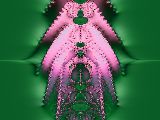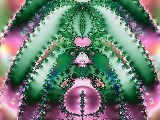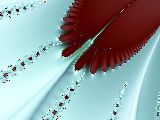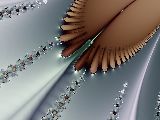Color, the final frontier...
In Sterlingware there are 26 preset color options each with six RGB options. This makes for 156 different color settings to choose from. Actually, you will find that most fractals only look good with two or three color and RGB settings. However, to find those "best" settings you will always have to do some experimenting.
C o l o r M e n u
The color settings are really very simple to use. Choose a setting, 1-26 from the "Color" menu that looks okay and then modify that setting by changing the RGB in the "rgb" menu. Let's use formula 53, render 8 with no other special settings (no insideout, julia mode or transform) as our example. It should look like this:

Now click on the first "Color" menu. You will see that number 13 is selected which is the default color selection which also happens to be one of the best. Click on the "rgb" menu to see that the first option is also the default rgb setting, "1.)RGB". I refer to this as color setting 13-1. Here is what I think is a better setting: Change the "rgb" menu to option "2.) RBG". You should see this:

This is the color setting 13-2 and is the one I used for the fractal on the table of contents page for this tutorial. You may have preferred 13-1. You can change the color settings at any time to any setting you want and change them back at any time, it won't affect the fractal generation process or alter any fractal menu settings. Coloring, as far as I can tell is an independent function and merely determines the fractal's appearance. Let's try 26-1.

And now for the only thing you have to look out for: Some color settings have an initial appearance which changes slightly after zooming or regeneration. Try 22-1.

Now try zooming-in one click. This is how it looks now.

The color changes when you zoom in or regenerate the fractal, but it will stay with this new coloring style if you zoom in more or change the fractal generation settings again. If you want to check that the initial color that you see is the permanent one without doing any zooming, just click on the "Apply" icon  or on "Draw" in the "Image" menu.
or on "Draw" in the "Image" menu.
The color settings I use the most are 13, 14, 16, 24, and 26. The best RGB setting I find varies quite a bit although 13-2 usually looks good. You will always have to experiment a little as some fractals will look good on number 13 and other formulas will create a fractal that looks better on 14 or 16 and not so good on 13. While learning to use the program it will simplify things if you just stick to 13-1 as this is generally a good setting.
C o l o r M i x i n g C o n t r o l s
One of the most creative things you can do with Sterlingware is to make new color settings with the "Color Mixing Controls" dialog box. Making changes to the "Steps", "Start" and "Render" settings can change a fractal's appearance tremendously.
Compare these two fractal images:


They both have a color setting of 14-5, but the second (right) has had its default dialog settings changed to produce a metallic coloring style. How was this done? By randomly changing the values and fiddling with them until I found something that looked good. I suggest you don't play with "Saturation" and "Offset". I have never been able to change them in any way that looked good and I always ended up resetting them to their default settings (127.000).
Once, I took the expiry date off a medicine bottle (99,07,03) and used it for my Red Green and Blue settings. Next I increased and then decreased the "Render" value. Finally, after about fifteen minutes of fiddling with all the values a little, I moved one of the "Step" boxes and arrived at a new setting that looked good. These new changes to the "Color Mixing Controls" will remain even if you change the color menu option number or any of the options in any other menu (like formula, render, etc..). Also, the new color settings will be saved in the parameter file (.loo) and can be retrieved and used to color new fractals by loading the parameter file and then generating new fractals with that file.
Color settings 6-12 when modified in the "Color Mixing Controls" can create some very vibrant, bright color styles. I never use them in their default setting. 13, 14, 20 and 24 give more subdued, earthy colors when altered. Changing the "Render" value by 0.2 can completely transform the appearance of a fractal. You may find it frustrating at first, but finding a good setting is well worth the trouble considering that it can be applied to over a million fractal settings.
P a r a m e t e r F i l e s D o w n l o a d
I have made 50 parameter files available for download as a zip file. Each parameter file (.loo) includes all the information to reproduce the original menu settings which I used to make the images displayed in my Gallery. To use them, just click on "Load from Parameter File" in the File menu or use the icon bar  . You can make any changes you want to the fractal settings and substitute different Formulas or Render methods, they will all have the loaded color settings as long as you don't make changes to the color dialog values or the color menu number.
. You can make any changes you want to the fractal settings and substitute different Formulas or Render methods, they will all have the loaded color settings as long as you don't make changes to the color dialog values or the color menu number.
If you want to reproduce the Sterlingware images exactly as they appear in my Gallery then open the "XY size" dialog box from the "Dialogs" menu and type in Width 300, Height 400 and click on "Apply." If you keep the "XY size" dialog open (visible) then every parameter file opened will automatically be the size of whatever the Width and Height values displayed are. If you close the "XY size" dialog, then every parameter file you open will be the default size of 160x120.
If the "Parameters" dialog box (eg. iterations, bailout...) is left open then it will overide the parameters in a parameter file (.loo) and generate a fractal that looks different. So, close the "Parameters" dialog before opening a parameter file (.loo).
You can do whatever you like with these parameter files. There is no copyright or any restrictions on them. You can make new images derived from these parameter files and post them on your website, try selling them, or whatever. I have made them available as examples, allowing you to see all the program settings that went into the images in my Gallery. Sort of like fractal source code.